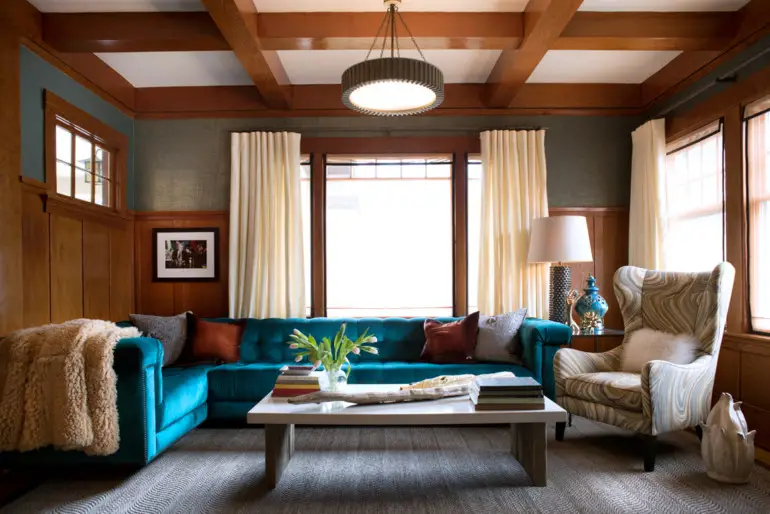Design collaboration brings color and texture to the sumptuous interior of this otherwise unassuming San Rafael craftsman.
BOTH INTERIOR DESIGNER HOLLY KOPMAN and client Raquel DiSabatino are quick to bring up the custom teal sofa the designer convinced the client to install in her textbook 1909 Craftsman home. Teal might seem like an unlikely sofa color choice for a Craftsman, but everything in the rock-and-roll– influenced interior of this home, tucked onto a nondescript corner of a nondescript neighborhood in the San Rafael flats, is both surprisingly unusual and absolutely right.

The project started as a quick cleanup. DiSabatino hired Sausalito-based Kopman at first to do a mild renovation — adding a powder room and removing some of the Craftsman details, including a pantry. But what started as a low-key project took on high-design priority once DiSabatino, now in her 40s, stepped into a new, independent chapter in her life, embracing the remodel as a chance to express her own particular aesthetic. After years of listening to music at San Francisco’s famous Fillmore and working as a marketing executive at the intersection of music and technology, “I am definitely more rock ’n’ roll edgy” than the home originally conveyed, DiSabatino says.

Accordingly, the designer helped her transform the look of the place, formerly closer to Pottery Barn, into the eye-catching, ultra-luxuriously textured vibe it has now. It appears to contain a lifetime’s worth of collections, though almost all the pieces were bought specifically for this house and brought together in a funky, chill-without- being-lazy, visually compelling-without-being-busy way. Everything was designed to walk the fine line between honoring the bones of the home and bringing in an utterly contemporary feel.

Flavor Paper wallpaper from Brooklyn adds a pebbly sheen to the dining room wall that Kopman fondly calls “the prom wall,” for DiSabatino’s practice of taking staged prom-like party photos in front of it. A custom Kopman-designed chandelier hangs in the dining room over a custom Evan Shively wood table made from a single slab of wood over a base designed, again, by Kopman. A layering of cool colors like greens and blues helps counteract the Fillmore shade of red DiSabatino chose; a Moroccan red in the bedroom lends an air of deeply sensual sanctuary.
It sounds like there’s a lot going on, but DiSabatino compares Kopman’s knack for putting seemingly disparate elements together to that of a chef: “I think of design like food; it’s the perfect blend of everything.”

The word collaboration comes up a lot with these two, who became friends over the course of the project and realized they’d probably been in each other’s social orbit for years. “We’d talk, and then I’d sit at my computer and we’d email pictures back and forth,” Kopman says of how they began to work together. DiSabatino would tell Kopman how badly she wanted a purple office; Kopman would encourage her to think about the visual and design value of a custom furniture piece.
DiSabatino relished the exchanges and found they helped her begin to translate her ephemeral desires — for a cool, somewhat edgy mood that also worked as a lively yet relaxing setting for herself and her 7-year-old son.

“She’s like a coach — like a very cool sexy designer coach,” DiSabatino says of Kopman. A very responsible coach, as well; as the scope grew, so did the budget, but it’s one Kopman stuck to. “She focuses on where you should really invest your money,” DiSabatino adds; for instance, the designer showed her how one expensive item could negate a need for 35 moderately expensive pieces. Hence the custom additions — the teal sofa, the dining table — that are so visually strong they can anchor entire rooms.
The home is “really a reflection of her personality,” Kopman says. “Once we started getting the wallpapers up and the decorative stuff in, it started to take on a life of its own.” Asked if the look — sumptuous, multivalent — is representative of her general aesthetic, she says it isn’t, actually. Her projects, she says, are “always more of a reflection of a client … with my influence.”

The vintage mirrored credenza is hers; the red is DiSabatino’s. And how does it all fit into this unassuming Craftsman? “I felt like I needed to honor that house,” Kopman says, “but make it feel modern too.” An example of the two aspects coming together is in the kitchen, where modern white tile and updated cabinet hardware play visually off the stained original wooden trim.
The house is a surprise, but the connection between the designer and client is rare. “It got to the point where she was finishing my sentences,” DiSabatino says. “It was a match made in heaven,” Kopman adds.


